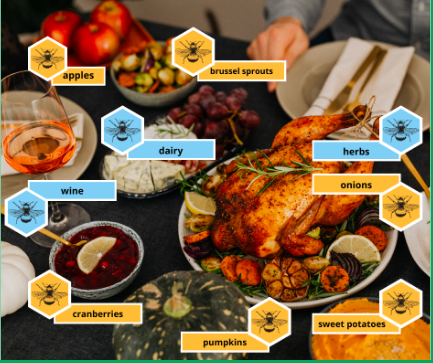Honey, I Shrunk Thanksgiving!
Thanksgiving is a time to gather and give thanks for family, friends, and of course, food. Little do we know that as we work to prepare these delicious meals, bees are working even harder to pollinate the essential ingredients for these cherished recipes.

Thanksgiving is a time to gather and give thanks for family, friends, and of course, food. Little do we know that as we work to prepare these delicious meals, bees are working even harder to pollinate the essential ingredients for these cherished recipes.
Bees are responsible for pollinating over one-third of all our crops, including those that are popular for holiday cooking such as apples, cranberries, pumpkins, broccoli, and more. While fruits and vegetables would be primarily impacted by the decline of bees, it wouldn’t just stop there. Bees also pollinate alfalfa, which is used to feed cattle for dairy and meat production.

While there are other pollinator insects and small animals, such as butterflies and hummingbirds, they are not as efficient as bees. A single bee colony can pollinate up to 300 million flowers each day. In fact, bees and flowers have evolved together to have a mutually beneficial relationship. These amazing insects contribute around $15 billion in added crop value.
Sadly, these workers do not receive their fair share of benefits. Bee populations have steadily declined since 2006 when a phenomenon known as Colony Collapse Disorder (CCD) was first observed. This disorder occurs when a majority of worker bees abandon their hive and queen, leading to the death of the colony. Although CCD has not been observed in several years, colony loss is still a major issue. In 2020, US beekeepers lost over 45 percent of their honey bee colonies, which is the highest recorded loss rate since 2006.
The number one cause of colony loss during this period was varroa mites. These harmful pests can decimate colonies by invading hives and spreading disease, and they are very challenging to manage. While it may be difficult to eliminate the threat of varroa mites, other leading causes of colony decline, such as pesticide poisoning, are directly related to human behavior. Pesticides may even make bees more susceptible to parasites like varroa mites.
Neonicotinoids (neonics) are a newer class of pesticide that is of growing concern. This potent insecticide is used across more than 150 acres of US farmland. Although most crops treated with neonics are not pollinated by bees, the chemicals are easily spread to other plants through runoff. Flowers miles away from these crops can absorb these chemicals and pass them to bees through their pollen and nectar. While they were once thought to be safe for bees and other non-target insects, recent research has shown that they are harmful to many different species.
Direct contact with neonics can be lethal for bees. However, indirect contact through pollen and nectar can have equally negative outcomes. Instead of dying immediately, the bees’ behaviors are gradually altered. Bees exposed to neonics have been found to stop disposing of other dead and sick bees, leading to a decline in the colony’s health. Affected hives are more likely to lose their queen, leaving them unable to reproduce and maintain their colony. In fact, neonic exposure has been found to cause fertility issues that can persist for generations.
In addition to behavioral effects, neonics also hinder the motor skills of bees, such as flight ability and navigation. Reduced sense of taste and smell can also occur from neonic exposure. These disruptions cause bees to have peculiar foraging habits, such as traveling further than necessary for food. With their unique cognitive and physical abilities impaired, bees are unable to thrive.
Although the future for bees may appear grim, it doesn’t have to be. You can give back to bees by planting a variety of native flowering plants in your yard. You can also help by avoiding pesticide use or opting for safe, natural alternatives. Those without yards can still make a difference by contacting elected officials about restricting neonics. You can take quick action and contact your state legislator here.
Authors
Elly Boehmer
State Director, Environment Virginia
A former canvass director and organizer with Impact, Elly now directs Environment Virginia's efforts to promote clean air, clean water and open spaces in Virginia. Elly lives in Richmond, Virginia, where she enjoys gardening, photography, hiking and rollerblading with her dog.

